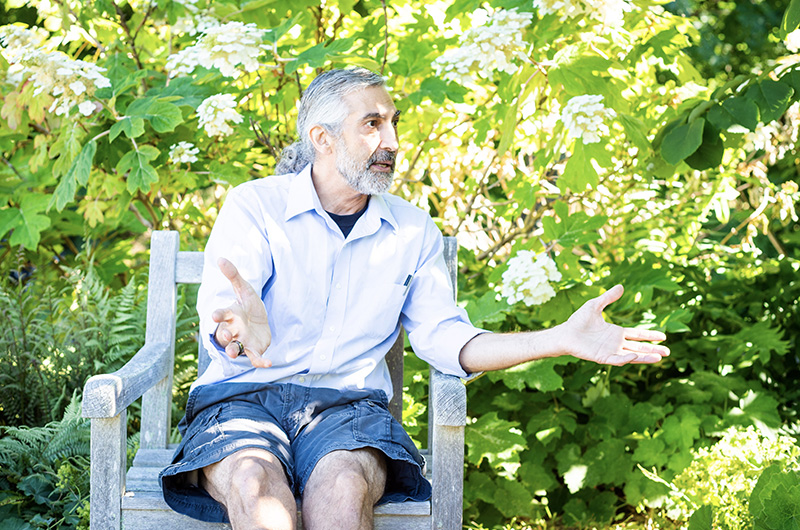Deep in the Manuel F. Correllus State Forest Wednesday night, Dr. Paul Goldstein pointed to a moth clinging to a white sheet strung between two trees. The moth was illuminated by a black-light hooked up to a car battery.
“This is another group of moths that don’t have a lot of sex appeal,” Mr. Goldstein said.
His specimen was from the moth subfamily Herminiinae. These moths are small, grayish and commonly known as “litter moths.” In front of him about three dozen people listened intently in the dark, gathered together for Moth Night, an event hosted by BiodiversityWorks.
Mr. Goldstein was, yes, talking about the sex appeal of a moth to humans.
Mr. Goldstein is a lepidopterist, an expert on moths and butterflies. He has been collecting specimens on Martha’s Vineyard since he was a boy, and began his formal study of Vineyard lepidoptera at Felix Neck in 1986. His goal, in the more than three decades since, has been to compile an index of all Island moths and butterflies. He estimates that’s more than 2,000 species.

“I’ve always been really, really interested in trying to revisit the historical stuff,” Mr. Goldstein told the Gazette.
A seasonal resident of the Island, Mr. Goldstein migrates from Washington, D.C., where he works as an entomologist for the National Museum of Natural History, and the United States Department of Agriculture’s systematic entomology laboratory, which looks to identify potential pests carried by imported produce.
At Moth Night, he opened with a brief talk on moth ecology and taxonomy before gathering guests around insect “traps” (the white sheets illuminated by nearby lamps) placed throughout the forest. It was at these traps that Mr. Goldstein explained, among other things, the finer points of lepidopteral sex appeal.
For other moths, the Herminiinae specimen is sexy indeed, he said. That’s because it grows pheromone emitters all over its body. They pop up on the legs, abdomen, thorax, even the wings. They do, however, lack the more conventional “sex appeal” that attracts moth and butterfly collectors to other local varieties. These collectors like to search for distinctive traits like the crimson eye spots of the Io’s back wings, or the mottled, leafy patterning of the Imperial moth.
But Mr. Goldstein feels this focus on aesthetics among collectors can distract from the study of ecology and conservation. It can also leave the impression that moth and butterfly conservation efforts are preoccupied with stubbornly preserving certain endangered species that are little more than living art objects.
“I just think it’s a mistake to think of conservation as sort of beginning and ending with listed species,” Mr. Goldstein said. “It leaves the door open for a lot of misunderstanding.”
Mr. Goldstein tries to approach conservation by spreading a popular understanding of moths that highlights their broad ecological and scientific importance, not just their aesthetic value. For example, moths are often important pollinators in agricultural and forest ecologies, he said, and they are a key food source for local birds and bats.
“There’s a lot of biomass tied up in insects,” Mr. Goldstein said.
For scientists and conservationists, moths are a key bio-indicator species, he said. That means fluctuation in moth populations can clue conservationists into larger environmental changes, since caterpillar species often feed on only one particular plant or require very specific soil conditions in order to pupate.
A collapse of moth populations — which have been dwindling for decades throughout the northeast — could imperil local crops and much of the region’s larger fauna, he added.
On the Vineyard, Mr. Goldstein’s focus, he said, is helping the Island’s unique moth and butterfly habits thrive through building awareness. Martha’s Vineyard is one of the last places where glacial outwash and frost bottom sand plains still persist in New England (mostly in Katama, Aquinnah and the state forest). Pupating moths love to burrow in these sandy and well-drained environment, producing a shocking diversity of lepidoptera, he said.
“One of my concerns is... being able to help people understand how really valuable a lot of our natural areas are,” Mr. Goldstein said. “Not just because we think they’re nifty and not just because they’re unique in Massachusetts, but because they’re nationally significant.”
The Vineyard is one of the last holdouts for a number of rare sand plain species, he added.
Mr. Goldstein tries to get up to the Island as often as he can, he said, to continue his research. He described his new indexing effort as “systematic, if sporadic, but pretty intensive.” He doesn’t know when, or if, it will emerge in some final form. For now, he views each incremental paper as a kind of “progress report.”
In his conversation with the Gazette, he said that he hoped Moth Night had brought its attendees a new understanding of moths’ importance while also “demonstrating the fun” of lepidoptery as a science. He wants a kind of engagement that moves past aesthetic “sex appeal.”
The large turnout for the event is a strong indicator, Mr. Goldstein said, that interest in moths and the natural world still blooms on the Island.
“The Vineyard’s lucky in the sense that there’s so many people who are superb naturalists.”
He hopes the next generation of scientists can keep the knowledge, passion and the conservation effort alive.







Comments (2)
Comments
Comment policy »